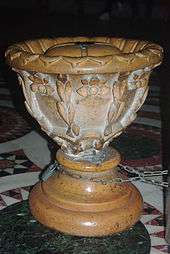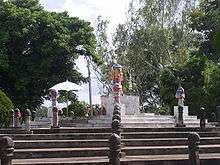Omphalos
An omphalos (ὀμφαλός) is a religious stone artifact, or baetylus. In Greek, the word omphalos means "navel". In Greek lore, Zeus sent two eagles across the world to meet at its center, the "navel" of the world.[1] Omphalos stones marking the centre were erected in several places about the Mediterranean Sea; the most famous of those was at Delphi. Omphalos is also the name of the stone given to Cronus. In the ancient world of the Mediterranean, it was a powerful religious symbol.[2] Omphalos Syndrome refers to the belief that a place of geopolitical power and currency is the most important place in the world.[3][4]
Symbolism
The omphalos was not only an object of Hellenic religious symbolism and world centrality; it was also considered an object of power. Its symbolic references included the uterus, the phallus, and a cup of red wine representing royal blood lines.
Delphi

Most accounts locate the Delphi omphalos in the adyton (sacred part of the temple) near the Pythia (oracle). The stone sculpture itself (which may be a copy), has a carving of a knotted net covering its surface, and a hollow center, widening towards the base. The omphalos represents the stone which Rhea wrapped in swaddling clothes, pretending it was Zeus, in order to deceive Cronus. (Cronus was the father who swallowed his children so as to prevent them from usurping him as he had deposed his own father, Uranus).
Omphalos stones were believed to allow direct communication with the gods. Holland (1933) suggested that the stone was hollow to allow intoxicating vapours breathed by the Oracle to channel through it. Erwin Rohde wrote that the Python at Delphi was an earth spirit, who was conquered by Apollo and buried under the Omphalos. However, understanding of the use of the omphalos is uncertain due to destruction of the site by Theodosius I and Arcadius in the 4th century CE.
Jerusalem


The omphalos at the Church of the Holy Sepulchre, Jerusalem, represents, in Christian mediaeval tradition, the navel of the world (the spiritual and cosmological centre of the world).[5] Jewish tradition held that God revealed himself to His people through the Ark of the Covenant in the Temple in Jerusalem, which rested on the Foundation stone marking the centre of the world.[6] This tradition may have stemmed from the similar one at Delphi. The omphalos has a collection box chained next to it. (See picture)
Art
Omphalos is a public art sculpture by Dimitri Hadzi formerly located in the Harvard Square, Cambridge, Massachusetts under the Arts on the Line program.[7] As of 2014, the sculpture has been deinstalled; it will be relocated to Rockport, Massachusetts.[8]
Literature

In literature, the word, omphalos has held various meanings but usually refers to the stone at Delphi. Authors who have used the term include: Homer, Pausanias, D.H. Lawrence, James Joyce, and Jacques Derrida. For example, Joyce uses the term in the novel, Ulysses,
- ""Billy Pitt had them built," Buck Mulligan said, "when the French were on the sea but our's is the omphalos."" (chapter 1),
- "...to set up there a national fertilising farm to be named Omphalos with an obelisk hewn and erected after the fashion of Egypt and to offer his dutiful yeoman services for the fecundation of any female of what grade of life soever who should there direct to him with the desire of fulfilling the functions of her natural." (chapter 14),
- "One of her sisterhood lugged me squealing into life. Creation from nothing. What has she in the bag? A misbirth with a trailing navelcord, hushed in ruddy wool. The cords of all link back, strandentwining cable of all flesh. That is why mystic monks. Will you be as gods? Gaze in your omphalos." (chapter 3)
Other examples include,
- In Indiana Jones and the Peril at Delphi (1991), the omphalos (the MacGuffin), is described as a small smooth black cone with a knotted petrified net covering its surface. It allows the holder to see into the future.
- In Thieves' House, a Fafhrd and the Gray Mouser story by Fritz Leiber, Omphal is the name of a set of bejeweled bones, those of a long-dead master thief.
- In The Unteleported Man (1966; republished as Lies, Inc.) by Philip K. Dick, Omphalos is the name of a ship.
- In Grave Goods by Ariana Franklin, the character, Mansur, describes Glastonbury Abbey as an omphalos.
- In Dead Sky, Black Sun, a Warhammer 40,000 fantasy novel by Graham McNeill, the Omphalos Daemonium is trapped in Chaos armour.
- Pawn of the Omphalos is a novel by E. C. Tubb.[9]
- A line in Seamus Heaney's poem, "The Toome Road",reads: " O charioteers, above your dormant guns, it stands here still, stands vibrant as you pass, the invisible untoppled omphalos."
- In Chapter 14 of James Rollins' SIGMA Force novel The Last Oracle, Gray and his entourage explore a replica of the Temple at Delphi, built into the cliffs along the Indus River in Punjab India. Inside, they find a secret passageway that leads downstairs to a sacred room, in the middle of which they find a carved omphalos that replicates the one at Delphi.
- The band Krux's song "Omfalos" (2002), describes the descent of a man to the center of the world, a world of darkness and mystery.
- Philip Henry Gosse published Omphalos: an Attempt to Untie the Geological Knot and thereby created what has been called the Omphalos hypothesis.
- The musician Michael Idehall has a song "Omphalos" on his Ant-Zen Records album Deep Code Sol (2015), which mentions the darkness and the light within the Omphalus.
Geographical references
- Cusco
- Göbekli Tepe
- Hill of Uisneach
- Kaaba, Black Stone
- Nishiwaki, Hyōgo
- Mexico (among others, one supposed etymology states the word means "the navel of the Moon")
- Tenri, Nara
- Wat Phra That Doi Chom Thong, Thailand
- Yanggu County, Gangwon
See also
| Look up omphalos in Wiktionary, the free dictionary. |
Sources
| Wikimedia Commons has media related to Omphalos. |
- Burkert, Walter (1985). Greek Religion.
- Dehoqu (1925). Dishi.
- Farnell, Lewis R. (1896). The Cults of the Greek States.
- Goodrich, Norma L. (1990). Priestesses.
- Guthrie, W.K.C. (1955). The Greeks and their Gods.
- Hall, Manly P. (1928). "The Secret Teachings of All Ages: Greek Oracles". Sacred texts.
- Harrison, Jane Ellen (1912). "Themis: A Study of the Social Origins of Greek Religion". p. 396.
- Holland, Leicester B. (1933). "The Mantic Mechanism at Delphi". American Journal of Archaeology. 37 (14): 204–214.
- "Homeric Hymn to Pythian Apollo". OMACL.
- Oswald, Pierre Jean & Kitsikis, Dimitri (1977). Omphalos. Paris.
- Rohde, Erwin (1925). Psyche.
- Shafer, Joseph R. (2011). Literary Identity in the Omphalos Periplus.
- Trubshaw, Bob (February 1993). "The Black Stone - the Omphalos of the Goddess". Mercian Mysteries. 14.
References
- ↑ Voegelin E. (2000). Order and History, Volume 2. University of Missouri Press. p. 31. ISBN 9780826263933.
- ↑ Ciholas P. (2003). The omphalos and the cross. Mercer University Press. p. 6. ISBN 9780865547834.
- ↑ Murphy C. (2007). Are We Rome?: The Fall of an Empire and the Fate of America. Houghton Mifflin Harcourt. p. 44. ISBN 9780618742226.
- ↑ Winther, Rasmus Grønfeldt (2014) World Navels. Cartouche 89: 15-21 http://philpapers.org/archive/WINWN.pdf
- ↑ Ezekial 38,12, a homily on the phrase, the nations...that dwell in the middle of the earth.
- ↑ Tanhuma Buber, Kedoshim paragraph 10.
- ↑ "Public art". Cambridge, Ma website. Retrieved 15 July 2012.
- ↑ Edgers, Geoff (November 11, 2013). "Hadzi sculpture in Harvard Square to get fixed, then moved". Boston Globe. Retrieved 28 December 2013.
- ↑ Tubb, E. C. (2011). Pawn of the Omphalos. Hachette UK. ISBN 9780575107663.